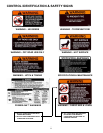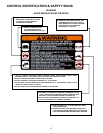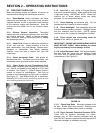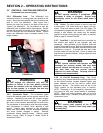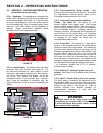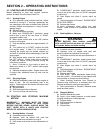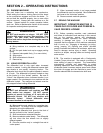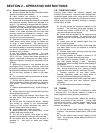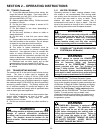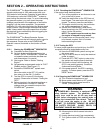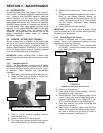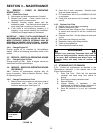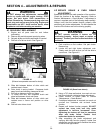
17
SECTION 2 – OPERATING INSTRUCTIONS
2.7.3. General Operating Procedures
A. Always complete the Pre-Start Checklist before
starting or operating the machine.
B. Learn location and function of all controls
before starting and operating machine.
C. Do not start or operate the machine until seated
with seat belt securely latched and adjusted to a
snug fit. The machine is equipped with an Operator
Protective Structure. This structure can protect the
operator and one passenger against injury from a
tip-over accident if used properly. Both must be
seated in the seats provided with the seat belts
securely latched and adjusted to a snug fit. Seat
belts that are not latched or are not adjusted to a
snug fit will not provide protection.
D. Operate the machine at a safe speed. Reduce
speed when hauling loads, towing, on slopes and
on rough or loose surfaces. The operator must
exercise sound judgment and adjust the speed of
the machine based on operating conditions. Driving
too fast for conditions can cause loss of control,
accidents, injury or death.
E. Do Not overload the machine. On level
surfaces, the maximum capacity of the cargo bed is
500 lb (227 kg). Reduce load when operating on
slopes. Limit loads to those you can safely control.
Maximum capacity, including two occupants, 900 lb
(408 kg).
F. Maximum occupants 2: one operator and one
passenger, 400 lb. (181 kg.) maximum. Both must
be properly seated in the seats provided, with seat
belts securely latched and adjusted to a snug fit.
G. Do Not carry children or others in the cargo
bed.
H. Do not operate machine across face of slopes.
Operate up and down.
I. Do Not shift to neutral and coast down slopes.
When descending a slope apply brake to maintain a
safe speed. Avoid turning when descending a
slope.
J. Reduce speed before turning. Avoid turning on
slopes.
K. Always lower the cargo bed and latch securely
before operating machine.
L. Before leaving the machine, Stop engine. Set
the park brake. Shift transmission to neutral and
remove key.
M. Do Not park the machine on slopes. Starting
and turning on slopes is not recommended.
Parking on flat surface eliminates the need to
perform these maneuvers on slopes.
N. Avoid sudden starts, stops and turns.
O. Apply brakes with a firm steady force. Avoid
sudden stops and skidding tires.
P. The use of a helmet, face shield or safety
glasses and substantial clothing is recommended.
Q. Be familiar with the area that the machine is
operated in. Stay alert for holes and hidden
hazards.
2.8 CARRYING LOADS
Carrying loads affects the handling, stability and
braking of the machine. Improper loads, shifting loads,
excessive speed, sharp turns, rough ground, loose or
slippery surfaces and slopes can cause loss of control,
sliding and/or tip-over accidents resulting in damage,
serious injury or death.
A. Do Not exceed the maximum capacity of the
machine. The maximum cargo bed capacity on
smooth level surface is 500 lb (227 kg). Reduce
load on rough ground and slopes.
B. Loads must be centered in the cargo bed and
secured to prevent shifting. Off center loads and
shifting loads can cause tipping and serious injury
or death.
C. Loads must not be stacked higher than the
sides of the cargo bed.
D. Always distribute loads evenly in the cargo bed
and keep loads as low as possible to minimize
effect on stability.
E. Reduce speed when carrying loads and allow
extra distance for stopping.
F. Do Not operate on slopes in excess of 10
degrees (18% grade) when carrying loads.
G. Tires must be properly inflated (15 psi. front
and rear) before carrying a load. Improperly
inflated tires affect handling, stability and braking of
the machine.
H. Do Not attempt to dump loads from the cargo
bed. Always remove load first. Raising a loaded
cargo bed can affect stability, resulting in tip-over.
I. Operate machine up and down slopes.
Release accelerator pedal and apply brake to
maintain safe speed when going down slope.
J. Do Not operate machine with cargo bed raised.
Always close bed and latch securely before
operating.
K. Do Not raise cargo bed when on slopes.
2.9 TOWING
The Turf Cruiser™/Trail Cruiser™ is fitted with a Class
1 receiver hitch. The vehicle, however, is rated at a
lower tongue and towing capacity (see below).
Towing as with carrying loads, affects the handling,
stability and braking of the machine. Towing loads
requires extra caution. Reduce speeds when towing
and avoid slopes whenever possible. Allow extra
distance for stopping.
A. Do Not exceed rated towing capacity of the
machine. The maximum towed load is 1000 lb (454
kg).
B. Do Not exceed rated tongue capacity of the
hitch. The maximum tongue weight on the hitch is
100 lb (45 kg).
19



